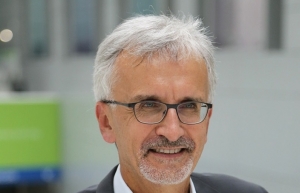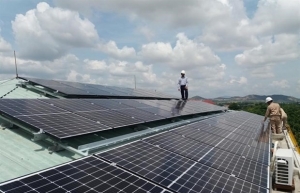Private sector expected to support the green growth model in Vietnam
Vietnam’s net-zero commitments made at COP26 last year will require deep transformations of business practices and consumer behaviour – and most importantly it will require very large investments such as wind farms, photovoltaic power stations, electricity grid upgrades, energy storage, and carbon capture. Coal-fired power plants will have to be shut down and replaced by low-carbon technologies.
 |
| Patrick Lenain, senior associate of the Swiss-based Council on Economic Policies |
Vietnam will also have to adapt to climate change: heatwaves, storms, droughts, floods, and extreme weather events will be more frequent. Road infrastructure in coastal areas will need to be protected, cities vulnerable to flooding will have to shield their public transport network, and farmers hit by seawater intrusion will have to relocate.
This will be costly. The World Bank estimates that a cumulative investment of $368 billion will be required during 2022-2040, far beyond the current investment pace of $8 billion made per year.
The bulk of this investment should go to adaptation ($254 billion) due to Vietnam’s high exposure to climate change.
Achieving the carbon net-zero commitment would require mitigation spending of $114 billion through 2040, both for low-carbon capital and social programmes. These estimates come with a degree of uncertainty and will undoubtedly be revised several times.
Whatever the exact cost, it will have a large financial impact. With government debt already close to the ceiling of 65 per cent of GDP, and large needs for other priorities such as education and health, it will be hard to find public budgets for large projects.
Fortunately, Vietnam successfully attracts foreign private investors, which can also help to progress on a decarbonisation pathway. Mobilising domestic private sources – bank loans and bonds – should also be on the agenda.
Attracting private investment
In 2017, the government decided to offer attractive feed-in tariffs (FiTs) to suppliers of solar power delivered to the grid. The price paid by the government guaranteed a return sufficiently high to attract investors – leading to a surge of 100,000 solar panels installed on rooftops. The government also drastically reduced red tape, making electricity generation more business-friendly.
The surge in solar panels was sizeable, but not large enough to reduce the long-lasting dependency on fossil fuels. Coal, oil, and gas still accounted for three-quarters of Vietnam’s primary energy consumption in 2021 – little changed over the past three decades. Clearly, more needs to be done.
Vietnam has very large untapped sources of solar and wind power, which could be brought to life by companies with the right technology. The private sector has the ability to do this. For example, Danish companies Ørsted and Vestas are quick to manufacture, install, and operate wind turbines, based on their experience in their home nation, which they have now deployed all around the world.
For this to happen, business conditions need to be more attractive. Green investments typically come with high upfront costs, complex technologies, long time horizons, currency fluctuations, and institutional uncertainties. Vietnam is generally attractive to foreign investors, but more could be done in the power sector. The transmission and distribution of electricity is still a state monopoly, closed to private investors, unlike in many other countries.
Also, more operating licenses need to be offered for private investments in renewable energies – and at the right price. Instead of FiTs, many governments now prefer to use auctioning mechanisms, as this is a better way to reveal the market rates that businesses can sustain. Auction mechanisms, with a transparent bidding process, are preferable to FiTs, which can result in overly generous electricity purchase rates.
Blending public and private finance can also make it more attractive to private investors to take the risk. Public-private partnerships (PPPs), where the private sector comes alongside a government agency, are attractive to investors not only because they reduce the underlying investment risk, but also because governments help to ease the regulatory burden.
Vietnam passed in June 2020 its first law on PPP investment, and the government has subsequently issued decrees on their implementation and financial management. Such partnerships are a good channel to bring technologies, expertise, and know-how into sectors traditionally dominated by state enterprises.
This would make sense to help Electricity of Vietnam (EVN) expand the power transmission grid and invest in future capacity needs, such as energy storage, and investigate the potential of carbon capture and storage for sectors that are hard to decarbonise.
PPPs must be handled with caution, so as to avoid burdening the public sector with contingent liabilities and future debts if projects are less successful than expected. Vietnam’s approach is very conservative, thus protecting fiscal sustainability, but it needs to be also enough attractive.
Loans and funding
Vietnam’s banking system is playing a growing role in the green transition. Credit institutions have increased their outstanding credit to environmentally-friendly investments. For instance, the spectacular take-off of photovoltaic solar panels installed on rooftops was largely financed through domestic banks.
Further credit expansion would be facilitated by a clearer taxonomy of activities considered climate-friendly by authorities. At present, Vietnam has not yet issued its own taxonomy, as done by Malaysia and Indonesia, and it has not yet adhered to international definitions of green investments. Adopting such a taxonomy would provide clarity to banks, and it would encourage green investment from institutional investors such as life insurance and pension funds.
Becoming a member of the Network for Greening the Financial System would also help the State Bank of Vietnam and bank supervisors familiarise themselves with the best practices in this area.
Around the world, green bonds have become the most important tool of climate finance. What makes green bonds a good vehicle for the climate is that the proceeds from the bonds must go to green projects with proven environmental benefits. Global issuance of green bonds reached about $620 billion in 2021, double that of the previous year.
In Southeast Asia, banks located in Indonesia, Malaysia, and Thailand have altogether issued more than $43 billion in green bonds in the past five years. However, Vietnam remains an exception: only $216 million in green bonds have been issued by Vietnamese banks in the past five years.
Steps to develop the issuance of green bonds include the following: promoting credible environmental, social, and governance ratings that issuers could use to entice investors; building a legal framework that will set the scene for the dialogue between regulators and market participants; making the green bond market operate with the help of quasi-public entities willing to lead the way.
To help low-income countries make progress toward green growth, the governments of developed economies have agreed to channel climate funding of $100 billion annually in 2020. While the quantitative pledge was not precisely met, developed countries have sharply increased their funding, which reached $83 billion in 2020. These funds came from bilateral donors ($31 billion), multilateral agencies ($37 billion), and private funding catalysed through public enhancements ($13 billion).
Fast growth has enabled Vietnam to reach the status of a lower middle-income country, and concessional flows have therefore declined. Non-concessional flows play a greater role in Vietnam’s green transition.
For instance, in 2018 Agence Française du Développement allocated EVN a non-sovereign loan of around $80 million aimed at strengthening the electricity distribution network in the southern region of the country. This involves nearly 540km of distribution lines and electrical substations which will transport electricity produced by renewable energy plants, and will thus alleviate the pressure on the existing transmission network.
To make the most of international funding, Vietnam should focus on blended finance, which has emerged as a valuable tool for unlocking private capital. Blended finance reduces the risk of climate-related investments, especially in developing countries. In Vietnam, this can take the form of blending concessional funding with commercial financing to ensure that funding is deemed feasible by private-sector investors. Another approach is to provide guarantees and insurance products as well as support for project preparation and financial structuring.
With its carbon net-zero commitment, Vietnam has shown a great sense of global responsibility. However, the transition will be too costly for the government to finance alone. Unlocking private capital, setting a framework for bank green lending, establishing a green bond market, enticing blended finance, and working together with foreign donors on commercial terms are all promising channels of climate finance that Vietnam could access in the future with the right reforms.
 | Can Vietnam achieve its goals on net-zero emissions? Vietnam’s economic achievements have been impressive over recent decades but greenhouse gas emissions have risen alongside them. Patrick Lenain, former assistant director at the Organisation for Economic Co-operation and Development, looks at the carbon market for this country moving forward as it tries to meet major emission-reducing targets. |
 | Vietnam needs extra 368 billion USD to achieve net zero emissions As the energy industry has a crucial role in achieving net zero emissions by 2050, it requires a structural transition toward green growth. Therefore, Vietnam needs assistance from developed countries regarding both financial and technical issues. |
 | Backing up Vietnam’s COP26 goals Vietnam’s strong commitment to reduce greenhouse gas emissions over the next few decades is receiving major support from the international community. |
What the stars mean:
★ Poor ★ ★ Promising ★★★ Good ★★★★ Very good ★★★★★ Exceptional
Related Contents
Latest News
More News
- Heavy industries set for pilot greenhouse gas quotas (December 25, 2025 | 10:00)
- Swedfund invests in MSME growth and climate action in Vietnam (December 19, 2025 | 11:42)
- GreenYellow brings solar energy to light up remote schools in Tuyen Quang province (December 19, 2025 | 08:00)
- Charge+, Grab partner to develop EV charging network in Vietnam (December 18, 2025 | 17:11)
- Linking sci-tech and innovation to Vietnam’s net-zero future (December 18, 2025 | 14:31)
- Driving double-digit growth through green and circular transformation in Vietnam (December 17, 2025 | 09:00)
- Standard Chartered and ACCA deepen collaboration to develop Vietnam’s talent for a sustainable future (December 15, 2025 | 18:18)
- Schaeffler reports strong early output from Dong Nai solar project (December 12, 2025 | 15:16)
- Forestry conference highlights biodiversity and sustainability goals (December 09, 2025 | 13:35)
- Home Credit honoured among top 10 sustainable companies in trade and services (December 09, 2025 | 12:18)

 Tag:
Tag:



















 Mobile Version
Mobile Version